Suzanne Wold-Burkness and W.D. Hutchison
Department of Entomology, University of Minnesota
Introduction
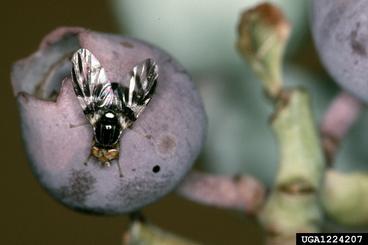
The blueberry maggot, Rhagoletis mendax is a pest of plants within the Vaccinum genus, including commercially grown blueberries, wild blueberries, and lingonberries. Blueberry maggots feed within the berry, leading to unmarketable fruit. Fortunately, even though it is native to North America, blueberry maggot has not yet been found in Minnesota. However, in 2016 it was confirmed in two counties in Central Wisconsin. Because of its continued range expansion, Minnesota blueberry growers should be aware of this pest and it’s potential to spread to Minnesota.
Biology
The adult blueberry maggot is a shiny black colored fly that is approximately ½ cm in length. Distinguishing features of the fly include the shiny black thorax with a white dot at the tip (scutellum), and clear wings with solid black “W” or “M” shape markings (Fig. 2). Blueberry maggot adults look identical to apple maggot (R. pomonella) (Fig. 3), and can also be confused with cherry fruit fly (R. cingulata) and black cherry fruit fly (R. fausta). Proper identification relies on wing band ratio, female ovispositor length, and male genitalia.
Although not as reliable as the former characters, the assumption is that if a Rhagoletis fly is captured in blueberries, it is likely blueberry maggot.
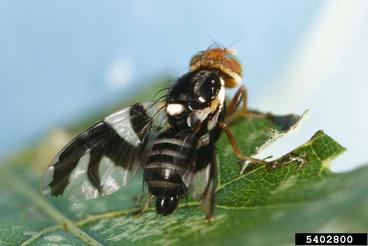
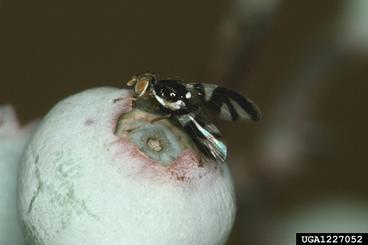
Damage
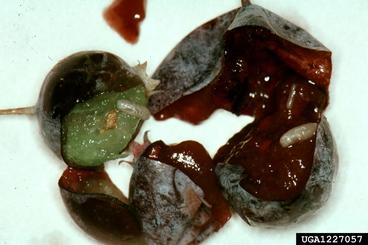
Blueberry maggots overwinter as pupae in the soil. In Southwest Michigan, adult flies emerge around the last week of June with emergence continuing through July and into early August (Isaacs 2017). In general, emergence tends to coincide with berry color change. After emergence, female flies actively search for nectar from flowering plants. Females require approximately 7 to 10 days to become sexually mature and mate, at which point they will begin laying eggs. Eggs are inserted under the skin of ripening blueberries, with a single egg deposited per fruit. Eggs hatch in about five days and the maggots (larvae) begin feeding, completing their development within a single berry. Upon maturity, the maggots drop to the ground and burrow into the soil to pupate, where they will remain until the following spring.
Blueberry maggots feed within the berry (Fig. 4), and as a result the berry becomes soft and drops from the plant. Sometimes symptoms of larval feeding won’t appear until after the fruit are harvested and sometimes not until the fruit is in possession of the consumer.
Management
We are currently monitoring for Blueberry Maggot and will continue to work on developing the best possible recommendations. We will make this information available through factsheets and/or web updates on FruitEdge and VegEdge. Growers who suspect they may have found blueberry maggot should collect samples and contact the MN Pest Alert Program, at: [email protected].
Monitoring
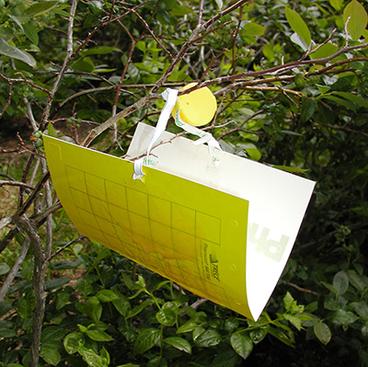
Blueberry growers should monitor using a “v-oriented” yellow sticky card (Geddes et al. 1989) baited with ammonium acetate. The ammonium acetate mimics the early food source (nectar) for adult flies. Michigan State researchers recommend placing traps within the canopy 1-2 weeks before berry ripening begins, and to continue monitoring throughout the season.
Cultural Control
Several practices that can be used include scheduling timely harvests and removing over-ripe fruit from fields as soon as possible to minimize blueberry maggot egg lay and larval development. To minimize egg laying and larval development, growers in other regions of the country have sent pickers through fields with one container to collect good fruit and another container to collect over-ripe fruit, which is discarded. This practice may work better in small scale situations vs. large scale commercial operations.
Chemical Control
The strategy behind the chemical control of blueberry maggot has been to kill the adults (flies) before they begin to oviposit, as there is no effective way to control the larval stage. Current recommendations suggest applying an insecticide within 5-7 days of catching the first fly.
Michigan State University (MSU) found that in field trials with high pest pressure and two-week application intervals, the performance of spinosyn insecticides was rated good-excellent against blueberry maggot. In addition, Exirel is a new insecticide from the diamide chemical class that has demonstrated excellent control of blueberry maggot in MSU trials.
References
Geddes, P.S, J.-P.R. Le Blanc, K.L. Flanders, and H.Y. Forsythe Jr. 1989. Environ. Entomol. 18(3): 510-512.
Guédot, C. and J. van Zoeren. 2018. Blueberry Maggot. UW-Extension. Retrieved from https://hort.uwex.edu/articles/blueberry-maggot/
Cesar Rodriguez-Saona, C. Vincent, D. Polk, and F. Drummond. 2015. A Review of the Blueberry Maggot Fly (Diptera: Tephritidae). J. Integ. Pest Mngmt. 15:1. Retrieved from https://doi.org/10.1093/jipm/pmv010
Geddes, P.S., J.-P.R. Le Blanc, and W.N. Yule. 1987. The blueberry maggot, Rhagoletis mendax (Diptera: Tephritidae), in eastern North America. Rev. Entomol. Quebec 32: 16–24.
Isaacs, R. Battling bugs in blueberries. 2017. Isaacs EXPO 2017 proceedings.
Midwest Fruit Pest Management Guide. https://ag.purdue.edu/hla/hort/pages/sfg_sprayguide.aspx
Teixeira, and R. Isaacs. 2007. Options for organic management of blueberry maggot. Michigan State University Extension, Department of Entomology.
Updated April, 2021